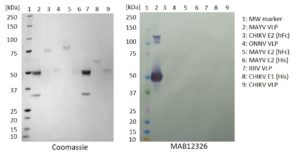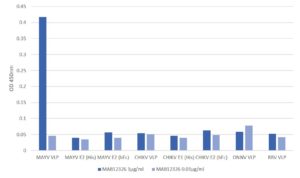
Western blot: Antibody is specific for Mayaro virus-like particles (Lane 2; MAYV VLP) containing E1 protein. MAYV VLP contains capsid protein (~29kDa), Spike glycoprotein E2 (~47kDa) and Spike glycoprotein E1 (~48kDa). It did not cross-react with MAYV E2 (Lane 5; human Fc-tag, Lane 6; His-tag), Chikungunya virus VLP (Lane 9; CHIKV VLP), CHIKV E2 (Lane 3; human Fc-tag) or CHIKV E1 (Lane 8; His-tag), O’nyong nyong virus VLP (Lane 4; ONNV VLP) and Ross River virus VLP (Lane 7; RRV VLP).

ELISA: Plate was coated with 0.5µg/ml of antigens in 1X DPBS overnight at 2-8ᵒC followed by blocking for 1.5 h using 1%BSA/DPBS, 300µl/well. Plate was washed 3X using Tris wash buffer. 100µl of antibody dilution was added and plate incubated for 2h at RT, 800rpm. Washed plate 3X using Tris wash buffer. Added 100µl of Goat anti mouse IgG HRP antibody (1:5000 dilution) to all the wells and incubated for 1h at RT, 800rpm. Plate was washed 4X using Tris wash buffer and 100µl HKTMB added and incubated for ~2 min. at RT. 100µl 1M HCl was then added to stop the reaction and plate was read at 450nm. Antibody is specific for MAYV VLP in ELISA. It does not cross-react with MAYV E2, Chikungunya virus (CHIKV) VLP, CHIKV E1, CHIKV E2, O’nyong’nyong virus (ONNV) VLP or Ross River virus (RRV) VLP.
MOUSE ANTI-MAYARO VIRUS E1 (M952)
This mouse anti Mayaro virus E1 (M952) protein antibody is specific to MAYV. Suggested pairs include MAB12326 for capture paired with MAB12324 for detection. We also suggest MAB12324 for capture paired with MAB12325, MAB12326 or MAB12327 for detection.
PRODUCT DETAILS – MOUSE ANTI-MAYARO VIRUS E1 (M952)
- Mouse anti Mayaro virus E1 (IgG1, clone M952) is specific for Mayaro virus (MAYV) E1 and detects MAYV VLP in ELISA and Western blot.
- Immunogen used was recombinant Mayaro Virus E1 antigen, Strain Acre27.
- No cross-reactivity in ELISA with MAYV E2, Chikungunya virus (CHIKV) VLP, CHIKV E1, CHIKV E2, O’nyong’nyong virus (ONNV) VLP and Ross River virus (RRV) VLP.
- Purified by Ion Exchange. >90% purity by SDS-PAGE.
- Presented in phosphate buffered saline, pH 7.2 with 0.05% sodium azide.
BACKGROUND
The Mayaro virus capsid is composed of 240 capsid protein copies within a lipid membrane, through which 80 capsid spike proteins penetrate. The spike proteins are composed of E2 and E1 glycoproteins, which form heterodimers shortly after translation and associate into trimers when virions assemble. The E2 glycoprotein is primarily involved in attachment to host cells while the E1 protein mediates the fusion of the virus and host cell (Choi et al., 2019). Both E1 and E2 on the surface of virions are targets of anti-MAYV antibody responses.
Since MAYV’s characterisation in 1954 on the island of Trinidad, it has caused major outbreaks in South American countries, and reports have suggested that cases of MAYV infection may be higher than previously documented owing to similarities between symptoms of the co-circulating Mayaro, Dengue and Chikungunya viruses (CDC).
The Mayaro virus (MAYV) is a positive-sense, single-stranded RNA virus, of the Alphavirus genus of the Togaviridae virus family. MAYV is closely related to other the Alphaviruses such as Chikungunya, Semliki Forest and Ross River, that also produce a dengue fever-like illness, accompanied by long-lasting arthritis.
REFERENCES
- Center for Disease Control and Prevention (CDC): Emerging infectious diseases. Brunini, S et al (2017). High Frequency of Mayaro Virus IgM among Febrile Patients, Central Brazil. Research Letter. Volume 23, Number 6—June.
- Choi et al. (2019). Protective immunity by an engineered DNA vaccine for Mayaro virus. Neglected Tropical Diseases.
- Smith, J., Pugh, C., Cisney, E., Keasey, S., Guevara, C., Ampuero, J., Comach, G., Gomez, D., Ochoa-Diaz, M., Hontz, R., Ulrich, R. (2018). Human Antibody Responses to Emerging Mayaro Virus and Cocirculating Alphavirus Infections Examined by Using Structural Proteins from Nine New and Old World Lineages. Clinical Science and Epidemiology.


